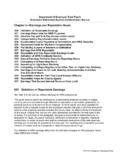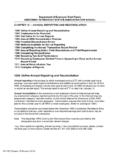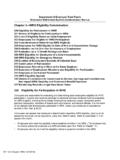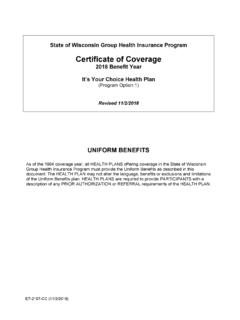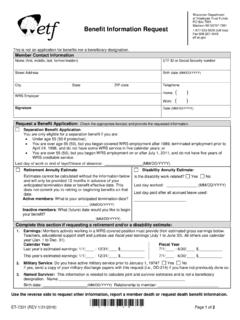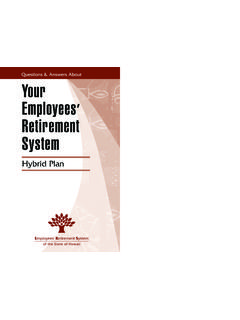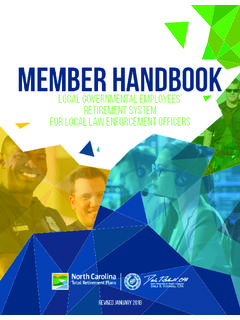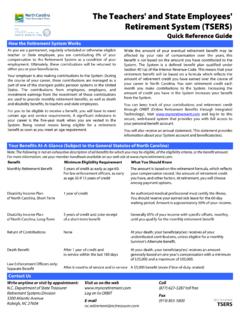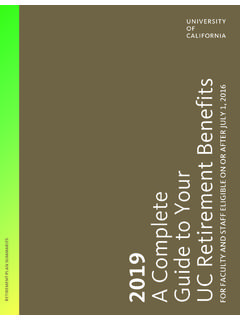Transcription of Contact ETF Your Benefit Handbook
1 your BENEFITHANDBOOKETFP O Box 7931 Madison, WI 53707-7931ET-2119 (REV 10/13)TABLE OF CONTENTSINTRODUCTION ..2 VESTING REQUIREMENTS ..2 WISCONSIN retirement SYSTEM ..3 retirement benefits ..3 retirement Plan Objectives ..3 Which Employers Participate ..3 Eligibility to Participate ..3 Mandatory employee Contributions ..4 Employer Contributions ..5 Additional Contributions ..5 Annual WRS Contribution Limits ..5 Participating in the Variable Trust Fund ..6 Interest Crediting ..6 Investment in Contract ..7 Social Security ..7 Social Security Number ..7 Qualified Domestic Relations Orders ..8 Obtaining Information about your Account ..8 Benefit Payment Options ..8 Distribution Requirements ..9 Rollovers to Another Plan ..9 Annual Statement of benefits ..9 your WRS ACCOUNT PROVIDES FOUR TYPES OF benefits ..10 Separation benefits ..10 retirement benefits ..11 Years of Creditable Service ..11 Buying Creditable Service ..12 Credit for Military Service ..12 Final Average Earnings.
2 13 Formula Multipliers ..13 retirement Age ..13 Formula Benefit Calculation ..14 Money Purchase retirement Benefit Calculation ..14 Reciprocity with County and City of Milwaukee ..15 Monthly Annuities and Lump Sum retirement benefits ..15 Break in Service ..15 Taking a Job After retirement That Is Not Covered by the WRS 15 Taking a Job After retirement That Is Covered by the WRS ..16 Disability benefits ..16 Death benefits ..17 BENEFICIARY DESIGNATION ..18 Who Completes a Beneficiary Designation ..18 Standard Sequence ..18 Completing a Beneficiary Designation ..19 GROUP INSURANCE benefits ..20 Group Life Insurance Program ..20 Group Health Insurance Program ..21 LONG-TERM DISABILITY INSURANCE CONTINUATION INSURANCE PROGRAM ..27 LONG-TERM CARE INSURANCE ..27 WISCONSIN DEFERRED COMPENSATION PROGRAM ..28 employee REIMBURSEMENT ACCOUNTS ..29 DOMESTIC PARTNER benefits ..29 WISCONSIN retirement SYSTEM PUBLICATIONS ..311 INTRODUCTIONThis Handbook provides general information about the provisions of the Benefit plans administered by the Department of employee Trust Funds (ETF).
3 The legal provisions governing these Benefit plans are in Chapter 40 of the Wisconsin Statutes, master contracts and the Wisconsin Administrative Code. ETF administers the following Benefit programs: Wisconsin retirement System Group Life Insurance Group Health Insurance* Wisconsin Public Employees* Local Annuitant Health Program for Public Employees* State of Wisconsin Employees Group Income Continuation Insurance* Wisconsin Public Employees* State of Wisconsin Employees Long-Term Disability Insurance (LTDI) Long-Term Care Insurance Deferred Compensation Program employee Reimbursement Account Program Accumulated Sick Leave Conversion Credits ProgramThe ETF Internet site contains video presentations on many of the topics covered in this Handbook . You may access them by going to and clicking on Members (Participants).The retirement Benefit calculation provisions described in this Handbook apply to individuals covered by the Wisconsin retirement System (WRS), but may not apply if your last date of WRS covered employment was before January 1, 2001.
4 Please review this Handbook carefully to determine which Benefit provisions apply to REQUIREMENTS You may have to meet one of two vesting laws in order for your employer contributions to be vested. This is based on when you first began WRS employment. If you first began WRS employment after 1989 and terminated employment before April 24, 1998, then you must have some WRS creditable service in five calendar years. If you first began WRS employment on or after July 1, 2011, you must have five years of WRS creditable neither vesting law applies, you were vested when you first began WRS employment. If you are vested, you may receive a retirement Benefit at age 55 (age 50 for protective category participants) once you terminate all WRS employment. If you are not vested, you may only receive a separation Benefit ( see page 10).OVERSIGHT OF ETFFive Boards oversee ETF. The Boards set policy and review the overall administration of the Benefit programs provided for state and local government employees.
5 The five Boards are: employee Trust Funds Board Teachers retirement Board Wisconsin retirement Board Group Insurance Board Deferred Compensation Board 2 WISCONSIN retirement SYSTEM (WRS) retirement BenefitsWRS benefits are calculated under two methods: The formula method is based on your final average earnings, years of service, formula multipliers for your employment category, and any actuarial reduction for early retirement . It is a defined Benefit calculation. The money purchase method is based only on your WRS retirement account balance and your age when your retirement Benefit begins. It is a defined contribution calculation. The money purchase retirement guarantees that your retirement Benefit will never be less than the annuity (monthly payments) that can be provided by your employee -required contributions plus an equal amount of employer contributions plus accumulated benefits are always calculated under both methods. You receive the higher of the two Benefit Plan ObjectivesIf you are a career public employee and retire at your normal retirement age, the intent is that your formula retirement Benefit plus your Social Security Benefit will produce a total retirement income between 50% and 85% of your pre- retirement earnings.
6 This objective was established by the Wisconsin Legislature in recognition that retirees normally pay less in income tax and have decreased full career of public employment is considered to be 25 to 30 years of service or more. You should plan on supplementing your retirement income with your own savings program, especially if part of your career has been employment not covered by the WRS or if you intend to retire early. You should also consider any benefits you may receive from other retirement Employers Participate The State of Wisconsin All Wisconsin counties except Milwaukee County Wisconsin Technical College System and/or districts Cooperative education service agencies (CESA) for teaching personnel; most also cover non-teaching personnel All public school districts for teaching personnel; most also cover non-teaching personnel Any other public employer in the State of Wisconsin that elects to participate except the City of Milwaukee and Milwaukee County, which have their own retirement : Certain cities and villages are only required to provide WRS coverage for eligible employees who serve as police or firefighters.
7 If you are employed by one of these cities or villages as a general employee or elected official, you are not eligible to participate in the WRS unless your employer elected to provide retirement coverage for all eligible to ParticipateDepending on when you began your job, your job will have to meet one of these two standards for it to be covered under the WRS. One-third standard A position that is subject to the one-third standard meets WRS participation standards if you are expected to work at least one-third of full-time (600 hours for 3non-teaching employees and 440 hours for teachers) for at least one year from date of hire. You will remain eligible even if your job subsequently drops below one-third. Two-thirds standard A position that is subject to the two-thirds standard meets WRS participation standards if you are expected to work at least two-thirds of full-time (1200 hours for non-teaching employees and 880 hours for teachers) for at least one year from date of hire.
8 You will remain eligible even if your job subsequently drops below two-thirds. If you were a continuing employee as of July 1, 2011, your job must meet the one-third standard. You will remain eligible even if your job subsequently drops below one-third. If you were hired after July 1, 2011: If you were a participating employee before July 1, 2011, left WRS service, did not take a separation Benefit , and are now returning in a new job, your job must meet the one-third standard. If you were a participating employee before July 1, 2011, left WRS service, took a separation Benefit , and are now returning in a new job, your job must meet the two-thirds standard. If you were not a participating employee before July 1, 2011, your job must meet the two-thirds standard.* If you are not expected to meet these eligibility criteria when you are hired, you will not be enrolled in the WRS at that time. However, if you subsequently work at least 12 months, and in any 12-month period you meet the hours requirement, you are prospectively enrolled in the WRS.
9 In this situation, your WRS coverage is not employee ContributionsIf your employment is eligible to be covered under the WRS, you must make employee -required contributions. These contributions are credited to your individual WRS account. These contributions are vested contributions are calculated as a percentage of your WRS earnings. The contribution rates are different for each WRS employment category. The rates generally change from year to year based on the recommendation of the consulting employer may have agreed to pay part or all of your employee required WRS contributions on your behalf, pursuant to a contract or collective bargaining agreement entered into prior to June 29, 2011. In addition, certain employees retained the right to bargain with their employers after that date over who will pay the employee -required contributions. Please Contact your employer for more information. employee Contribution RatesEmployment Category20132014 General/Teachers/Educational Support Protectives with Social Security Protectives without Social Security Elected Officials/Executive retirement 4* If you were hired on or after July 1, 2011, and before July 2, 2013, and were employed by a WRS employer before July 1, 2011 but were not covered by the WRS, your job must meet the one-third standard.
10 Employer ContributionsYour employer is also required to make contributions to the WRS. The intent is for employee and employer contributions plus investment earnings to be sufficient to fund the retirement benefits to which you will be employer contribution rates are adjusted each year, based on the recommendations of the consulting actuary. Employers also pay any other contributions for unfunded actuarial accrued liabilities, such as duty disability benefits (protective category employers only) and accumulated sick leave conversion credit program (state employees only).Employer Contribution RatesEmployment Category20132014 General Employees/Teachers/Educational Support with Social Security without Social Security Officials & State Executive retirement Plan ContributionsRegular Additional As a participating employee in the WRS you may make voluntary additional contributions to your account to supplement your regular WRS Benefit . You may make after-tax additional contributions either by payroll deductions through your employer or by direct payment to ETF.

